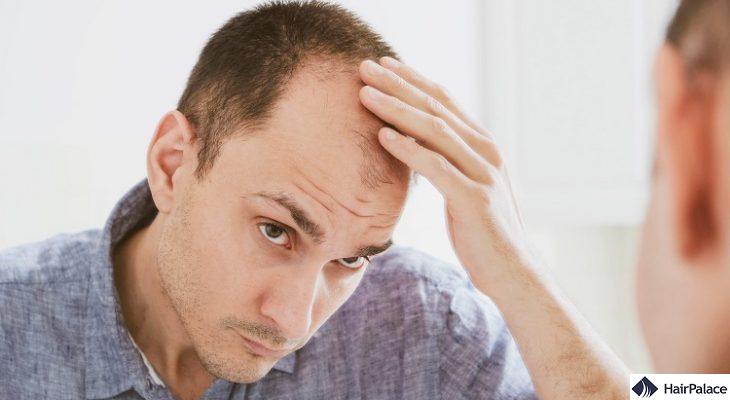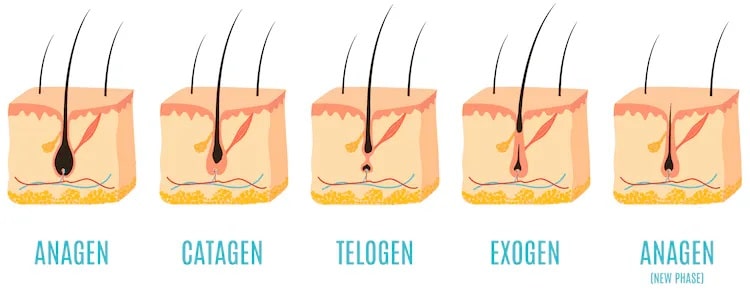How Much Hair Loss is Normal? Expert Advice

Whether it’s from showering, brushing or styling our hair, or simply changing our clothes, we lose hair all the time without even realizing it -it is simply part of our body’s natural renewal cycle.
But sometimes, we become paranoid that something more sinister might be at play, especially when we see large clumps of hair on our pillow, in our hairbrush, or gathering at the shower drain.
While hair loss is normal, there is, of course, a threshold. This article will help you find out what’s normal and what’s a cause for concern.
We’ll explore the most common triggers for hair shedding and hair loss and highlight simple changes you can make to improve the quality (and quantity) of your hair!
- Normal hair loss
- Hair life cycle
- Shedding vs Hair loss
- Causes of shedding
- How much hair loss is too much?
- How to stop hair falling out
- Conclusion
How much hair should you lose in a day?
The American Academy of Dematgolistis estimates that the average person loses between 50 to 100 hairs daily.
So is hair loss normal?
While 100 hairs might seem like a lot, this amount of hair loss is completely normal.
Our natural hair growth cycle is more than capable of replacing these hairs without us ever noticing.
Plus you must remember that we have over 100,000 hair follicles, which can more than cope with this loss.
Women tend to lose more hair daily than men, owing to increased hairstyling, hair care products, dyes, and treatments, and growing their hair longer.
Women are also more likely to shed hair early because of key life events like pregnancy and menopause.
How much hair loss is normal in the shower?
Because you are actively washing, cleaning, drying, and pulling at your hair during a shower, you can expect to lose more hair.
When looking at pictures of normal hair loss in shower you’ll find that you may lose as many as 150 to 200 strands. Shorter, thinner hairstyles can expect less.
You may lose more hair if you do not wash your hair regularly, as there is an increased buildup of dirt and dandruff that can be abrasive during washing.
If you notice prolonged hair shedding after your hair, this may signal that you’re experiencing a hair loss condition.
Remember to be gentle when washing and drying your hair, use a suitable comb with gentle strokes, and, where possible, avoid applying hot styling techniques to reduce hair fall.
The hair life cycle

Every hair on your body follows its own life cycle.
There are four stages, roughly taking two to five years to complete. Different hair may be at different stages at any given time.
The four stages include the following;
- The anagen phase is a period of rapid growth where cells divide to form brand-new hair. Up to 90% of hair is in this phase.
- The catagen phase is a short transition phase lasting two to three weeks. About 2% of hair is in this phase, where growth slows down and stops, and the hair follicle begins to shrink.
- The telogen phase is also known as the resting phase. Your hair neither grows nor falls out, though a brand-new strand is beginning to develop and replace it.
- The exogen phase is the last stage, where club hair is pushed out. Afterward, the follicle reenters the anagen phase, and new hair grows.
Of course, various factors can impact the hair growth cycle and how quickly hair sheds.
These include your diet and nutrition, how well you clean and care for your hair, and physical traumas like harsh hairstyling and hair pulling to decrease the rate of hair fall.
Hair shedding vs. hair loss
Although shedding is a core part of the hair’s natural growth cycle, certain factors can influence premature shedding and prevent the hair follicle from reentering its growth phase.
So what might start as simple hair shedding could lead to permanent hair loss.
One of the most common causes of this escalation is a hormone imbalance caused by dihydrotestosterone, otherwise known as DHT.
DHT is an androgen (sex hormone) found in both men and women and is derived from testosterone.
Initially, it helps men develop male attributes, but it has adverse effects when it reaches scalp hair.
Hair loss occurs when DHT shrinks hair follicles, preventing them from supporting new growth.
Some people are much more sensitive to DHT than others, and its thought genetics can make you predisposed to developing male pattern baldness.
If one of your parents developed pattern hair loss, there’s an increased chance you will too.
Most hair care specialists and professionals will use the Norwood scale to diagnose the extent and severity of male pattern baldness.
The scale has seven stages, each of which has specific criteria and patterns your doctor will use to help formulate an appropriate treatment.
Causes of excessive hair shedding
If you notice large clumps of hair falling out, you’re most likely suffering from excessive hair shedding.
Shedding is when hair reaches the later stages of its natural growth cycle.
This hair loss is often temporary, as hair will begin to grow again once it restarts into the anagen stage.
Several known events can trigger excessive hair shedding in healthy hair. They include:
- Prolonged periods of stress
- Hormonal changes in the body, including menopause
- Pregnancy and giving birth
- An underlying health condition
- Sudden weight loss
- Recovering after an operation or health scare
- Extreme hairstyling, including tight hairstyles like cornrows and tight braids.
Once you reduce stress and regulate hormone levels, excessive shedding should stop, and regular hair growth should return.
This might take between six to nine months.
That said, if hair does not recover, follicles may not be able to produce new strands, and you could be developing a receding hairline or even permanent hair loss.
How much is too much?
Firstly, losing a certain amount of hair each day is unavoidable.
Remember, normal hair shedding ranges between 50 to 100 strands each day.
If you are worried about the rate of hair you are losing, you can conduct a simple pull test to determine hair health.
Wash and dry your hair, and run your hands through a small area.
Gently pull, and examine how many hair strands were pulled out.
Any more than three hairs indicate that you may suffer from some form of active hair loss, and you should contact your dermatologist or doctor for a formal diagnosis to address your concerns.
How to stop hair from falling out
The best way to stop further hair loss from developing is to book a consultation with a qualified dermatologist.
They will examine your scalp and hair closely to diagnose probable causes for your condition, including whether you’re suffering from hair loss, shedding, or a combination of both.
They can then recommend the best action therapy, hair treatment, or medication.
You’ll also be given essential advice on improving your hair’s condition and quality, including simple ways to protect hair and avoid any unnecessary trauma to your scalp.
Conclusion
When hair falls out, it can be distressing.
But it is important to remember that it is a part of everyone’s life and is often only temporary.
The condition can be very concerning, especially if balding occurs in your early twenties.
When experiencing high stress levels, illnesses, or simply getting older, we may find increased hair strands on our pillows each morning.
So when should you be worried about hair fall?
Losing more than 100 strands per day is generally the threshold for concern.
Furthermore, if you see bald spots or thinning hair that spreads quickly, you should contact your doctor or haircare specialist for a consultation.
How Much Hair Loss is Normal? – FAQ
The average rate of hair loss is 50 to 100 strands per day. Any more than this can be a sign your hair is suffering.
Normal hair loss per day in male and female individuals including brushing is 50-100 hairs.
Hair grows slowly, on average, at about six inches per year. Thankfully, hair around your body is at different growth cycle stages, so losing strands each day should not be too noticeable.
It’s perfectly normal to lose a few stray strands when running your fingers, or a comb, through your hair. But if you notice increased hair being pulled out when you are being gentle, this can be a cause of concern that you should get checked over.
Children typically shed 50-100 hairs per day, similar to adults, but excessive hair loss may indicate an underlying issue like stress, illness, or nutritional deficiencies.
Last medically reviewed on January 29th, 2025
- Do you have hair loss or hair shedding? (n.d.).https://www.aad.org/public/skin-hair-nails/hair-care/hair-loss-vs-hair-shedding
- Burg D, et al. (2017). Promotion of anagen, increased hair density and reduction of hair fall in a clinical setting following identification of FGF5-inhibiting compounds via a novel 2-stage process. DOI:http://doi.org/10.2147/CCID.S123401
- Murphrey, M. B., et al. (2019) Anatomy, hair.https://www.ncbi.nlm.nih.gov/books/NBK513312/#_NBK513312_pubdet_
- Kovacevic, M., et al. (2019). Novel shampoo reduces hair shedding by contracting the arrector pili muscle via the trace amine‐associated receptor [Abstract]. https://onlinelibrary.wiley.com/doi/abs/10.1111/jocd.13054
- Cheng AS, Bayliss SJ, “The genetics of hair shaft disorders.” J Am Acad Dermatol 2008;59(1):1-22.


